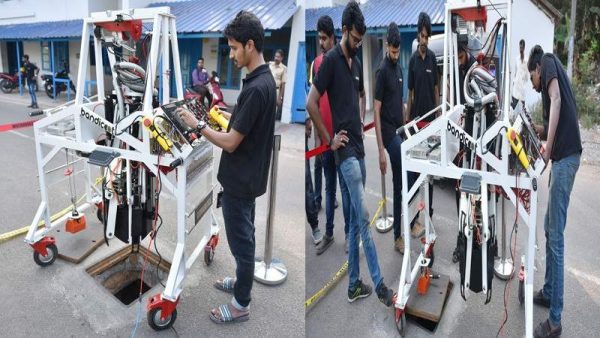
How Does Bandicoot work? Facts about the World’s First Scavenging robot
In Kerala, the first robot is developed for the scavenging the manholes and it is developed by the young team who are under 25 years. It was the start-up project of their company named “Genrobotics”. This robot is developed to clean the manholes not manually but by the semi-automated robot named ‘Bandicoot’ robot.

About Bandicoot robot
A semi-automated robot, Bandicoot is developed, designed and manufactured by Kerala-based startup Genrobotics. The mission is of the young team is to change the manholes to roboholes. It is started as a piolet project so that it can be improvised and optimized to use in various conditions. In 2017 the young team officially started working on this project, and in 2018 they launched Bandicoot’s Beta version.
The funds are provided by Kerala Startup Mission and the Kerala Water Authority and the robot is developed in the “Kerala Water Authority’s” office in Thiruvananthapuram. The approximate cost of a robot is Rs 10 lakh.
Structure and functioning of the Bandicoot robot
The young engineer team designed a Bandicoot robot in the shape of a spider. It has four limbs and a bucket system is also there to collect the waste. It needs to be operated by a person from a safe distance and able to see details in the monitor. 80 kg robot lift the heavy metal cover on its own and limbs can go inside the manhole. With the help of arms, solid waste is scooped out and dumps it in the bucket as the arms have 360degree mobility and many cameras are also fixed in the robot.
Genrobotics want to help the manual scavengers to have a healthy life by training them about how they can operate the robot. It will also help manhole cleaners to earn a decent living without any fear of losing lives due to the hazardous working condition and it can also break the caste system.
The first trial of Bandicoot
The first trail is done on February 15, 2018. In this trial, bandicoot entered in four manholes and cleared the drain in only one hour. And in the second trial, there is a challenge to clean a very old utility hole was also successful. The trail is done near the TVM’s Medical College area (Trivandrum Medical College). After the success, Kerala water authority has decided to use bandicoot to clean all the sewers in Thiruvananthapuram. This is also appreciated by PM Narendra Modi. An initiative is also taken to make capital clean and change manholes to roboholes.
Read more: How to effectively handle Midlife crisis?
What is manual scavenging & how many death is caused by it?
In India, the term manual scavenging is used to clean and remove the untreated human excreta manually from the pit latrines by hands with bucket and shovels. According to numbers collated by the National Commission for Safai Karamcharis (NCSK), one person dies in every five days, on an average, while cleaning sewers, septic tanks, and manholes across the country.
To eradicate manual scavenging from the Indian capital, the Delhi government has taken an initiative towards the robotic solutions for cleaning sewers and septic tanks. The Delhi government is inspired by the robot bandicoot. Delhi government has already taken the step to stop the human practice of manual scavenging.
Have a news story, an interesting write-up or simply a suggestion? Write to us at info@oneworldnews.in








